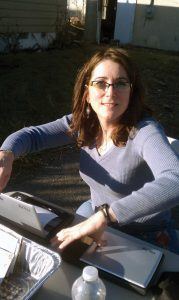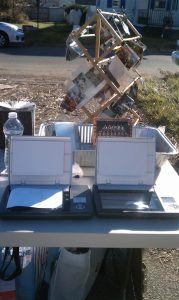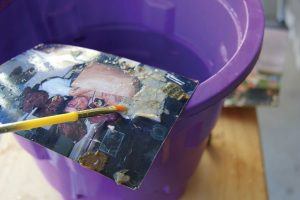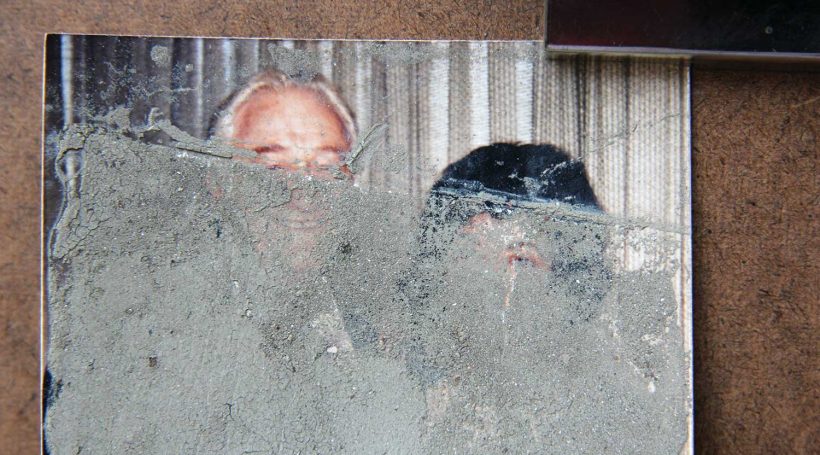

Mary Danielson
Months after Superstorm Sandy hit, Mary Danielsen slowly handed over a small stack of restored family photos to a young man who had lost his home and almost all of his belongings. “His grandmother had passed them down to him, and holding them in his hands again made him feel as if he got a little piece of his life back.”
That moment was a far cry from only weeks earlier, when Danielsen fought back tears when she first saw the devastating effects of Superstorm Sandy. The once pristine, tree-lined streets in Union Beach, where she bought her first house, had been destroyed. “The entire town was in a state of demolition,” she says.
“It was like a scene out of a movie. Appliances, furniture, clothing and other family belongings were piled as high as the eye could see. What once was safely behind closed doors was now vulnerably out in the open. In many cases, there were no doors left. Everything was literally inside out.”
Danielsen was about to embark on a long and emotional journey. “I couldn’t walk away from the devastation I witnessed without doing my part,” she says. So when she heard about a group of volunteers who were preserving washed-up photographs, she knew she had found her calling. As a historian, archivist and owner of Documented Legacy, a Mount Laurel-based business that preserves and documents everything from experiences and heirlooms to photos and more, Danielsen had the perfect background for the project. Almost immediately, she put her own work on hold and set out to volunteer her services. The grassroots neighborhood group was already in the process of rescuing, cleaning and digitizing photos that had washed away from homes and businesses.
“I knew I could use my knowledge and preservation background to make some good come out of a tragic time,” she says. And that she did, as thousands of photos started popping up all over town. “There was so much destruction. We were literally finding photos in the streets.”
For the team, which quickly set up makeshift “rescue” stations wherever they found usable locations, preserving memories was their main goal. “When a natural disaster invades private space, everyone looks for their valuables and sentimental belongings first, especially personal photos.” Word about the project spread through social media, and hurricane victims started showing up with newly found photos.
“Each time someone found a photo,” Danielson says, “it was a victory that kept us working to save more.”
One story Danielson says will always remain with her: “A family had packed a suitcase full of photos and left it by the front door of their house before evacuating. Among those were all the pictures of their son’s first seven years of life. They had to leave quicker than they anticipated and, in haste, left the suitcase behind. When I met the mother she was in a state of shock and grief over having lost the only evidence she had that her son existed for the first seven years. Her home and everything in it was gone, and she was having an extremely difficult time starting over without her photos.”
Danielsen remembers telling her to keep looking, that she would find something – and eventually she found one precious picture. “When she found the photo of her son, I could see the relief spread across her face, and she immediately calmed down. I knew at that moment she would make it through. That photo gave her hope.”


A grassroots neighborhood group worked in makeshift stations to restore hundreds of irreplaceable photos damaged by Superstorm Sandy
Moments like those were what kept the team going through challenging conditions. “It was difficult to find places to preserve photos due to the conditions of the area. We set up tables in what were formerly front yards and received permission from the township to work in the municipal building. As the photos kept piling in, we celebrated every successful cleaning because we knew how much our work was touching the lives of those who had lost everything. As a historian, I understand that things can be replaced but memories cannot. Old photos of loved ones cannot be recreated.”
So the process continued as thousands of photos were found. Many were covered in saltwater, sand, oil and grass but, for the most part, were salvageable. “Most photos are restored in a lab, but we did not have access to traditional arrangements. We did our best with what we had to work with,” says Danielsen.
The team devised a system of cleaning the photos with spring water and removing debris with a soft bristle brush. They received donated mobile scanners and, after a drying process, scanned the photos with deteriorated sections cropped out.
Eventually, they needed to somehow document the restored photos in hopes of connecting them with their owners. An archive was created in the town library, and information was posted on social media to inform the community about the project.
“We reconnected people with all kinds of photos,” says Danielsen. One homeowner, who wished to remain anonymous, described how he felt when he received his restored photos: “We lost every single thing we owned. A few days after the storm I logged onto Facebook and saw a picture of my daughter as a newborn in the hospital being held by my mom, who passed away five years ago. It was at that exact moment that I knew we would get through this. We have had quite a few pictures returned to us. These are things that can never be replaced. We have since replaced our ‘stuff,’ but the pictures are priceless.”


More than one year after the storm, her restoration mission continues, and Danielsen has made it a personal goal to educate the public about the importance of preserving their personal stories. “After Sandy, most people could not even think about rebuilding without their sentimentals, especially their photos. The first thing people do when they move in is hang pictures on the walls. When a house is filled with happy memories, it becomes a home again. Photos are place keepers in time; without them many people have no sense of foundation.”
More so now than ever, Danielsen realizes just how important it is to protect cherished and irreplacable family momentos from disaster. “Taking the time to conduct family interviews and properly preserving valuables such as photos, military medals, awards, collections, paperwork and other non-replaceable items can help keep stories together when the most unthinkable occurs.”
Danielsen truly believes uncovering photos helped Sandy’s victims heal. “This experience has been an eye-opener for me; one that you cannot put a price on. They say a picture is worth 1,000 words. If that’s that case, only a picture could tell this story.”










